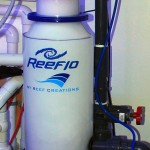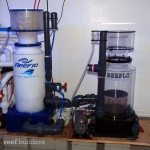
In the latter part of 2009 My Reef Creation released the new lines of Orca Pro skimmers featuring the needlewheel design and pumps of Reeflow. The Orca Pro-I unit is designed for systems of up to 500 gallon and retails at $1,299 while its larger brother, the Pro-II model is suited for systems of 400 to 1,000 gallon range and retails for $1,699. In the past, I have owned two Orca 250 units and have been happy with their performance. On first impression, the new MRC Pro-II closely resembles its predecessor the Orca 250. They have a similar footprint, same pump, similar overall look. On actual inspection of the unit, it becomes readily apparent looks aren’t everything and the new MRC Pro-II is very much removed from the antiquated Orca 250. The differences are not just cosmetic. In operation the Pro-II unit is quieter, creates a great deal more foam and is far more stable in its operation than I had previously found the Orca 250 to be. Follow along with me as I put the Orca Pro II to work on 1,000 gallons of reef.
Probably the first thing everyone notices about the new Orca Pro series is how great they look. These units are so clean in their lines and fittings that it would be a travesty to hide them under stands and in fish rooms. They look the part of a well made functional piece of equipment.
On removal from the box, the Pro skimmer is pretty much preassembled — requiring no more than a few minutes to screw in the elbows for the pump assembly (which are already pretaped — a very nice touch). This is a major improvement over the older grey connector used on the previous Orca series, which required a great deal of manipulation to get the air intake aligned without losing a watertight seal. Speaking with MRC about this aspect, they informed me that the pipework to and from the pump of each individual unit is actually preassembled and then glued to provide a matched set of pipes making a perfect fit for each skimmer. I have to admit — mine certainly was. The effluent is connected by a simple union and the airline fits on the aspirator with a simple push fitting. The only part requiring any labor is the water supply section. As fitted, this is a simple union to which a 3/4-inch pipe or nipple can be attached — I will come back to this later. While not apparent to most but most certainly an irritant to anyone who owned an Orca series, the fittings throughout the latest Orca Pro series are all in inches, and not metric. This makes connecting the water feed and the effluent pipes a far simpler venture than in the past.

Though similar in configuration to the Orca, the Pro-II has a number of distinct differences. Firstly it is quite a bit taller, this compensates for the slightly narrower reaction chamber which results in an overall volume that is most likely equivalent between the two units. The pump assembly is, however, quite different between the Pro-II and the Orca 250. This is most apparent when viewed from above. As can be seen, the Pro-II has an extended water path leading to the pump. This allows the incorporation of the new aspirator utilized in the Pro-II. Previously I had posted to Reef Builders a short review detailing the performance of this assembly. Coupled with the longer draw, the aspirator pulls so much air into the unit that the entire reaction chamber turns a milky white. This is in comparison to the older Orca 250 where the bottom third of the chamber was always devoid of bubbles. Since more bubbles equals more contact with a resulting increase in foam production, this is definitely a step in the right direction. The next feature of the Pro series that is a definite step up is the incorporation of a gate valve on the outflow side as opposed to the twist/bevel assembly of the Orca series. In operation, the gate valve is extremely sensitive and allows a much greater level of control over other methods of stabilizing the water level.
Moving up the reaction chamber is the cap and collection cup. Connected by a color matched blue flange, this assembly is a breeze to attach/detach for cleaning. The cup is predrilled on the side and fitted with a nipple to accommodate a drain line.
As mentioned earlier, the water feed to the skimmer is via a 3/4-inch intake. To my mind this represents the major drawback of the Pro-II (though not likely an issue for the Pro-I skimmer). To elaborate, the Pro-II skimmer requires a water flow of approx 600 g/hr. In my configuration, I gravity feed the skimmer directly from an overflow and, in the absence of pressure from a pump, I cannot get 600 g/hr through the 3/4-inch fitting, especially considering the restrictions further imposed by the internal diameter of the pipe nipple. This is not an issue if the skimmer is directly fed by a pump but, to my mind, the incorporation of a larger intake would be a major improvement of the unit and extend its versatility. Since the Pro-I model requires a much lower feed rate, the 3/4-inch fitting is more than adequate. While not a drawback, a valve on the airline would also be nice. Incorporating such would allow the operator to close off the airflow and lower the water level to perform cleaning on the unit as opposed to fully opening the gate valve, or cutting off the water flow to the skimmer. Having said that, a few dollars and a quick trip to the Home Depot can sort that minor issue out — and therein lies the beauty of using materials compatible with the American market.
Once assembled and water checked, the airflow was initiated and the skimmer given a few days to break in. During this time, a massive amount of bubbles were produced and after a day or so, a steady head of foam was collected. Adjusting the foam/water interface is a breeze with the gate valve and soon a dry foam was being forced out into the cup. As I mentioned above, the skimmer is whisper silent other than the slight noise of the pump. Incorporated into the unit is a packed air silencer mounted in a housing at the top of the effluent tower. I removed the fiber mesh packing in this cup and while the noise increased I didn’t notice an increase in airflow so returned it back to its normal set up. In operation on my large system I am producing a thick, dark and particularly foul smelling skimmate.
I have been running the Pro-II now for several weeks on my 1,000 gallon reef aquarium system and I remain happy with its performance. The foam is copious, steady and consistent and I haven’t experienced any leaks nor any overflows (which would sometimes happen with the Orca after a brief power outage). My initial good impression has lasted and apart from the narrow diameter pipework on the feed and the lack of an air valve, I cannot really find fault with the MRC Pro-II and would happily recommend it to anyone running a large system.
FTC regulations require that we inform you that we were given a discount on the purchase of this product for review, but our opinion of a product is never affected by how we acquire them.




